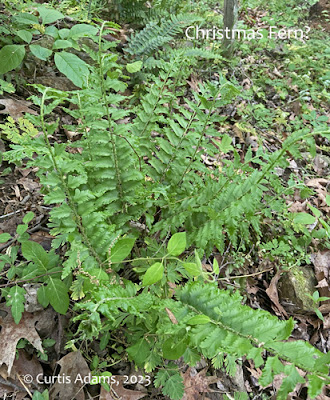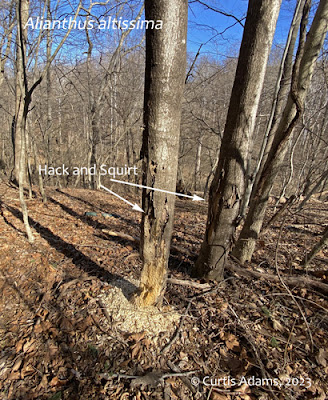 |
This is a pretty typical scene when English ivy gets established
in a tree. This ivy is robbing light from the tree and also weighing
it down, leading to limb breakage. Cutting a section of each vine
around the base of this tree will kill all the vine above the cut in a month or so. |
 |
Wintercreeper grows up trees with the aid of sticky rootlets.
Its evergreen foliage shades the host trees as well as
the surrounding area. In areas with plentiful deer the bottom 4'
are often stripped of foliage. The same can be seen with English ivy.
|
Winter is a very good time to have an impact on Mid-Atlantic
invasive plants. Many of these still
have leaves and are susceptible to herbicide treatments. It’s also easier to see where plants are
(though identification can be trickier). Most native species are dormant during
winter so there is less risk of damage from herbicides or from tromping through
the landscape. In can be more
comfortable to work in cooler weather.
As long as it is above 45°F, many herbicides are still effective (see
below).
When I look out at unmanaged areas infested with invasive
plants I see many opportunities to have a large impact on reducing the spread
of many of these species without a lot of effort. For some species just keeping them from
climbing up the tree will have a huge impact on controlling their spread. OF course complete removal for most of these
species will take several years of consistent effort, but just keeping them
from climbing trees can limit their spread and be much healthier for your
established trees and large shrubs.
Among the species that need to climb in order to bloom and
produce seeds are English ivy, Japanese honeysuckle, winter creeper, and oriental
bittersweet. These vining species
produce flowers when they are growing upwards or over the tops of other plants. You can significantly reduce their seed
production by keeping them from growing upwards. Most simply this can be done by cutting the
vines growing into trees and larger shrubs close to ground level. Applying the appropriate herbicide to the
stump will go one step further in eliminating that plant from the landscape. If you aren’t using herbicide, clear the
invasive from a zone around the base of a tree to help slow re-establishment of
the invasive vine.
The bittersweet, wisteria and honeysuckle grow upwards by
twining around their hosts. These vines
grow tightly around the trunks and branches of their host plants in effect
strangling them. While English ivy and
wintercreeper don’t twine as much (they climb with the help of sticky rootlets growing from the stem) its dense evergreen foliage gets very
heavy, especially in winter, and can bring down branches or even whole trees.
 |
Oriental bittersweet can grow vertically by twining around itself.
Once it finds a suitable host it will continue upward
growing around the host. I cut this one high last spring so
that I could come back later and treat a fresh cut with herbicide.
|
 |
This Japanese honeysuckle was cut last season. You can see
the damage caused by this tightly twining vine. |
The table below summarizes how to treat several of the
invasive species in fall and winter. All
this information was taken from the references cited. For details check out the links to the
references for each species. Before
using herbicide read and follow the label directions. Don’t forget to wear proper protective
equipment. Another important safety
practice in dealing with vines is to NOT pull them out of the trees after you
cut them. You risk damaging the tree and
yourself. They will dry up and fall out
on their own.
|
Invasive
|
Common name
|
Winter treatments
|
timing
|
Reference
|
|
Celastrus orbiculatus
|
Oriental Bittersweet
|
Cut stump treatment with 20% glyphosate or trichlopyr.
Digging/pulling partially effective, but plants can regrow from root
fragments.
|
Fall-Winter when temps above 40°F. Digging can be done anytime.
|
Bugwood
CO
|
|
Lonicera japonica
|
Japanese honeysuckle
|
Foliar treatments with glyphosate (0.75-1.5%) effective. Later in season higher concentrations are
more effective. Use for easily
accessible foliage (ground level).
|
After first frost but before hard frost are very effective. Mid-winter treatments were less effective.
|
Bugwood
LJ
|
|
|
|
Cut stump (25% glyphosate) for climbing honeysuckle vines
|
Cut stump most effective June-Winter
|
PRISM
|
|
Euonymus fortunei
|
Wintercreeper euonymus
|
Cut back climbing vines to prevent flowering and fruiting.
Small infestations can be dug out, but plants can regenerate from stem
fragments.
|
Anytime, the sooner the better.
Flowers form in summer with ripe fruits in fall on climbing
vines.
Dig plants when soil is soft and easily worked.
|
Forest
Service
|
|
|
|
Cut stem treatment with 25% glyphosate for climbing vines.
Foliar spray with glyphosate or triclopyr (2%) for large infestations on
ground
|
When temperatures are above 40°F.
Treat immediately after cutting.
Mid to late fall when other species are dormant. Best at or above 65°F.
|
TN
Exotic Plant Management Manual
|
|
Hedera helix
|
English ivy
|
Cut vines growing up trees close to ground and again 1-2’ up. If possible, treat cut stump with 25%
active ingredient glyphosate or triclopyr amine.
|
Cut stump method is effective year round. Herbicide treatment best when temperatures
are above 55°F.
|
Invasive.org
|
|
|
|
Foliar treatment with these chemicals (2-5%) when temperatures are
above 55°F are partially effective.
|
Foliar treatments most effective from mid-summer through fall. Partially effective in winter. Apply during mild periods (above 55°F)
while other plants are dormant.
|
|
|
|
|
Smaller non-climbing infestations can be manually removed. Plants can resprout from any remaining
roots or vine.
|
Pulling can be done anytime.
There are fewer competitive plants in winter.
|
|
|
Wisteria sp.
|
Wisteria
|
Cut vines about 2” from the ground.
Treat with 25% glyphosate or trichlopyr. Plants will resprout if not treated with
herbicide.
Small infestations can be dug out, but resprouting is possible from pieces
left behind.
|
Cut stump treatment can be done anytime that the ground is not
frozen.
|
Bugwood
|
NOTE: In most jurisdictions a home owner can apply OTC
herbicides to their own properties, but they are restricted from doing so on
public lands or on another person’s property.
In most cases a certified pesticide applicator is need to apply
herbicides to any property but your own.
Before attacking the invasive species it is important to be
able to know which plants are desirable and which are not. Some species are easy to identify in winter (e.g.,
English ivy and wintercreeper). Others
like oriental bittersweet, can be difficult to distinguish from their domestic
relatives. Check out this guide from the Delaware Department of Agriculture for help in identifying invasive plant species. Of course any vine that is
threatening the life of a desirable tree or shrub is a candidate for removal.
 |
This adolescent hickory tree sustained damage from
Japanese honeysuckle a few years back. The truck is swollen
due to sap being restricted from flowing up the tree. I'm not sure
if this tree will continue to survive into maturity. |
In looking over the nearby woodlands I noticed that most of
the native vining species do not spiral tightly around their host. Deciduous native vines like Virginia creeper
and native grapes do not twine so they do not strangle trees, and, since they
lose their leaves in the fall they do not add a lot of weight through the
winter. Native vines growing high into trees
can reduce the amount of light penetrating the tree canopy. One of the bigger problems on my property with
vines growing up in the canopy is that they join trees together so that when
one falls it can damage other trees that are connected through the vines. An important benefit of these native species
is that their berries are an import food source for many birds, poison ivy
included.
 |
Catbrier (Smilax sp.), the green stems here, is a native species that twines
loosely on itself as well as on other nearby plants. While it can
be a nuisance due to its stiff thorns it plays well with other established plants. |
Another group of invasive species that can be attacked in
winter are woody shrubs and herbaceous species that are still green and active
in the winter months. These include
multiflora rose (Rosa multiflora),
wineberry (Rubus phoenicolasius) and
garlic mustard (Alliaria petiolata). Last year I wrote a more detailed post
on how to deal with these species in the
winter.
As an update to that post, I did test whether burning the
crowns of wineberry with a garden torch was sufficient to kill it. In most cases the answer was no. Most of the crown resprouted later in the
spring. Another action took was to cut
back the long arching branches in late summer and fall. This shoud reduce its spread since it can
form roots wherever a branch tip contacts the ground. The effectiveness of this effort will be
difficult for me to measure but I hope to get a sense if there are fewer of
these out there.
For a general overview of Mid-Atlantic invasive species see Plant Invaders of Mid-Atlantic Natural Areas For detailed instructions on how to treat you
should look to nearby state resources or University cooperative extension
services.
What else can you do?
Aside from managing your own property there is not a lot an
individual can due by themselves or without permission. There are a number of ways to volunteer to
do plant conservation or get involved with removal of invasive species. I first got started working with native
plants by becoming a plant conservation volunteer with what was then the New
England Native Plant Society (now the Native Plant Trust). A number of our projects involved clearing
out invasive species from public and some private lands. We were trained on how to identify our target
and how to remove it.
To work on public
lands you need training and or supervision.
Contact the public lands supervisor for the areas where you want to
help. Some other places where you can
look for opportunities are plant conservation groups and state or regional
native plant societies. In Maryland
there are several counties with ‘Weed Warrior’ groups (for example see Weed
Warriors for Montgomery County). In Northern Virginia there are the Tree Rescuers. Also in Virginia there is Blue
Ridge Prism, a group dedicated to removing invasives from the forests of the
Blue Ridge Mountains. The USDA website has
some general information including a few specific links to projects around the
country. The Nature
Conservancy has a volunteer site that can be searched by location and date.

































